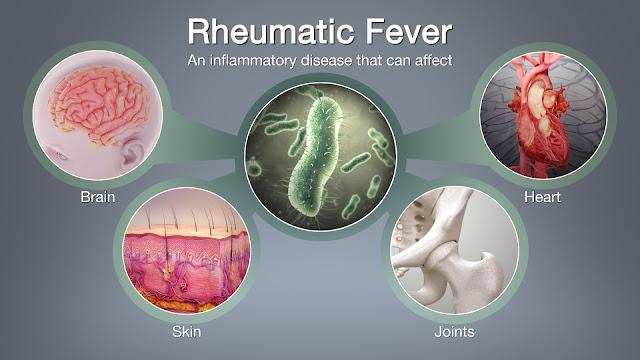Rheumatic Fever
Rheumatic Fever
Rheumatic fever is more commonly found in developing countries. Due to cross sensitivity reaction due to group A & B haemolytic Strep. Develops 2-3 weeks after a streptococcal throat infection (U.R.T.I) Upper respiratory tract infection. Exact pathogen is not known. Oedema and fibrinoid of collagen. Aggregation of lymphocytes and macrophages Aschoff's bodies form Mac Callam's plagues.
Streptococcal Sore Throat need to be handled carefully because, left untreated, it can lead to rheumatic fever with involvement of the joints and the heart.Symptoms : The patient has fever, a sore throat, pus points on the tonsils, and enlargement of the lymph nodes below the jaw, but no running nose, cough or redness of eyes.Treatment : You doctor may like to take a throat swab and do a blood test (A.S.O titre) to further substantiate the diagnosis Children with tonsillitis are given a course of antibiotic.
Introduction
Rheumatic fever can be a serious disease as it can involve the heart and can lead to chronic heart disease if not detected and treated in time.
Acute rheumatic fever is a illness that follows a streptococcus pyogenes infection. Most commonly seen in children age 6-15. It is believed that this is a cross reactivity caused by antibodies binding to sites such as the heart, brain and specially joints hence the name it takes after rheumatism.
The disease follows a sore throat with painful and tender lymph nodes under the jaws. This sore throat is caused by a specific bacterium. It should be distinguished from a sore throat to a viral infection in which the patient also has cough and a runny nose without enlargement of neck glands.
In typical case, a child of school going age (5 to 15 years) has a sore throat . One to three weeks later , he presents with flirting joint pain and swelling. It usually affects the big joints like ankle and knee. By flitting pain, we mean that joint involves becomes normal in a day or two while another gets affected. Then the second becomes completely normal while a third is found to be painful and swollen. Besides this typical problem with the joints, the patient also has fever. He may get a rash on the trunk which comes and goes. He gets nodular swellings on the back of the head or on the elbows and legs and the doctor may find that his heart is affected. Some cases present with abnormal voluntary movements of the body and limbs (chorea). The doctor may find some other features.
Diagnosis
History of recent sore throat
Throat Swab : Streptococcal bacteria
Blood Test : A.S.O.Titre
Diagnosis with Jones criteria either 2 major or 1 major + 2 minor or evidence of strep infection
Major criteria
- Chorea
- Carditis
- Erythema marginatum
- Poly arthritis
- Sub cute nous nodules
Minor criteria
- Fever
- Increase C.R.P and E.S.R
- Arthalgia increased P.R interval on E.C.G and + history
- E.C.G and echo needed
Chest X-ray
Electro - cardiogram (E.CG)
 |
| E.C.G |
Echo cardiogram for heart
Parthenogenesis
Rheumatic fever
Hemolytic Streptococcal sore throat infection with fever
Immunogenic reaction
Rheumatic fever 10 - 14 days later
Signs and symptoms
- Rheumatism : Inflammation occurs in the joints making it painful to move. The joints of legs are usually affected first, with the inflammation migrating to the upper joints.
- Fever of 100 to 102 Degrees F
- Streptococcal sore throat
- Migrating Poly Arthritis : Painful Joint : Poly arthritis - Tender painful joints (elbows, knees, ankle and wrists)
- Wrist inflammation.
- Heart : Carditis - Inflammation of all parts of heart primarily mitral valves. In 50% of cases the infection can spread to the heart and form bacterial vegetation. These usually targets the valves and cause life-long heart issues.
- Bacterial vegetation on tricuspid valve.
- Pericardial rub, pericardial effusion.
- Chest pain
- Narrowed mitral valve causing heart murmur. Heart murmur depends on valve affected.
- Cardiac failour
b . Subcutaneous nodules - Small non-tender swellings often over the joints.
- Nervous system (Sydenham's Chorea) Much longer gap for chorea. Chorea is involuntary movements of extremities and face affects speech. in 20-30% of cases damage can happen to the basal ganglion of the brain, causing spastic movements of the head face and limbs. This is known as chorea or St Vitus dance. Most cases resolves within 3-6 months, but extreame cases needs physical therapy. Can presents 3-4 months after GAS infection. Mean duration 12-15 weeks. Episodes may last 6-12 months.
- Twitching,jerking and muscle weakness.
- Abdominal Pain occur in some cases.
- Skin :
- a . Erythema Marginatum - (Non-itchy rash) A sub-cute nous rash that does not itch and forms rings that spread out with time. Red skin lesions starting on trunk and spreading peripherally.
 |
| Erythema marginatum |
b . Subcutaneous nodules - Small non-tender swellings often over the joints.
- Abdominal Pain
Treatment
If you are diagnosed with acute rheumatic fever you will be treated with antibiotics.
Anti-inflammatory medications such as aspirin or corticosteroids reduce inflammation to help to manage acute rheumatic fever.
You may have to take low dose of antibiotics (such as penicillin, sulfonamides or erythromycin) over the long term to prevent strep throat from returning.
Prognosis
- Rheumatic fever is likely to come back in people who don't take low dose antibiotic continuously, specially during the first 3-5 years after the first episode of disease. Heart complications may be severe particularly if the heart valves are involved.
Bed rest.
Treatment for the sore throat, and aspirin is commonly prescribed regimen. Let your doctor decide how long your child should stay at home. The more important point that you must remember is that further attacks of bacterial sore throat in children who have had rheumatic fever must be prevented. For that, the doctor will ask you to give the child a medicine to be taken regularly for a number of years. This is essential because further attacks can adversely affect the heart.
In case of tooth extraction, or surgery inside the mouth, the doctor will also put the child on a medicine just before and for some time after it. You must therefore tell the surgeon that the child has had rheumatic fever in the past, so that he can take the necessary precaution.
- Treatment strategies can be divided into management
- Acute attack
- Management of the current infection
- Prevention of further infection and attack
- Management of the acute attack
- Single dose of Procaine benzylpenicillin 0.6 mega units I.M daily for 8 days.
Benzyl penicillin 1.2 mega unit I.M every 3/52 or daily Oral phenoxymethyepenecillin 250 mg 6 hry for 10 day
- Penicillin Allergic- Erythromycin or cephalosporine
- Analgesic : Salicylates Aspirin at high doses (100 mg /kg body weight /day) maximum 6-8 gm per day for 2/52
Treat chorea if it occurs.
If a high risk and have a past history of rheumatic fever , prophylaxix given.
- Treatment is than directed towards limiting cardiac damage and relieving symptoms.
https://madhuchhandacdmo.blogspot.com/2021/02/rheumatic-fever.html







Comments
Post a Comment